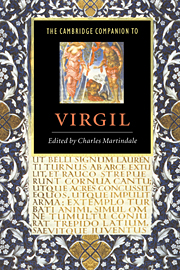Book contents
- Frontmatter
- Contents
- List of illustrations
- List of contributors
- Preface
- 1 Introduction: ‘The classic of all Europe’
- Part 1 Translation and reception
- Part 2 Genre and poetic career
- Part 3 Contexts of production
- Part 4 Contents and forms
- 16 Virgil's style
- 17 Virgilian narrative (a) Story-telling
- 17 Virgilian narrative(b) Ecphrasis
- 18 Approaching characterisation in Virgil
- 19 Sons and lovers: sexuality and gender in Virgil's poetry
- 20 Virgil and tragedy
- 21 Envoi: the death of Virgil
- Dateline compiled by Genevieve Liveley
- List of works cited
- Index
- Plates
16 - Virgil's style
from Part 4 - Contents and forms
Published online by Cambridge University Press: 28 May 2006
- Frontmatter
- Contents
- List of illustrations
- List of contributors
- Preface
- 1 Introduction: ‘The classic of all Europe’
- Part 1 Translation and reception
- Part 2 Genre and poetic career
- Part 3 Contexts of production
- Part 4 Contents and forms
- 16 Virgil's style
- 17 Virgilian narrative (a) Story-telling
- 17 Virgilian narrative(b) Ecphrasis
- 18 Approaching characterisation in Virgil
- 19 Sons and lovers: sexuality and gender in Virgil's poetry
- 20 Virgil and tragedy
- 21 Envoi: the death of Virgil
- Dateline compiled by Genevieve Liveley
- List of works cited
- Index
- Plates
Summary
Coleridge's famous question, 'If you take from Virgil his language and metre, what do you leave him?', is often taken to mean there is little but style to praise in Virgil, and Coleridge does speak elsewhere of Virgil's lack of 'deep feeling'. But the remark may have been prompted by Coleridge's reading a month before of Wordsworth's translation of Aeneid Book 1, and thus be a comment on how much is lost when Virgil is read only in translation. At the end of the twentieth century, the percentage of readers who encounter Virgil only in translation is much higher than in Coleridge's day (that specific comment comes from his Table Talk of 8 May 1824). Further, the tendency for those who do read Virgil in Latin to do so after only a few years of study of the language means that his Latin is not so much 'read' as translated or even 'metathesised', that is to say the Latin words are (at least mentally) rearranged and supplemented to fit some combination of the syntax of the reader's own language and his or her expectations of how a Latin prose sentence should read. At the same time, however, that fewer and fewer people on the planet can read Virgil's Latin either at all, or well, a tiny minority can arguably read the poet's language better than anyone has for several centuries.
- Type
- Chapter
- Information
- The Cambridge Companion to Virgil , pp. 241 - 258Publisher: Cambridge University PressPrint publication year: 1997
- 15
- Cited by



